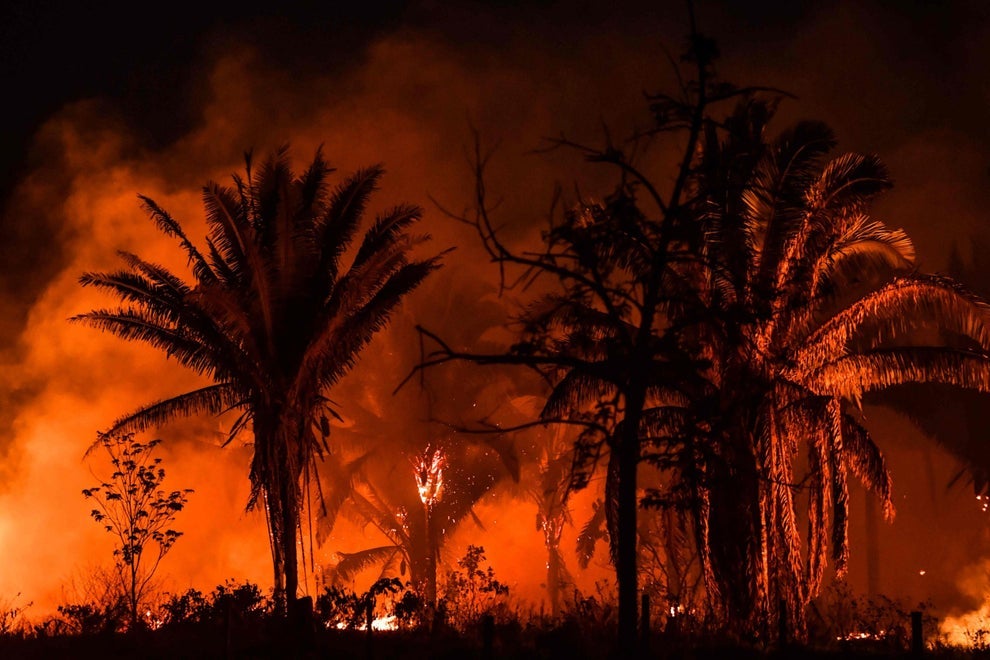Amazon forest fires continue to cause emissions years after burning out
Exclusive: Emissions from fires do not peak until four years after flames have stopped, according to new research

Your support helps us to tell the story
From reproductive rights to climate change to Big Tech, The Independent is on the ground when the story is developing. Whether it's investigating the financials of Elon Musk's pro-Trump PAC or producing our latest documentary, 'The A Word', which shines a light on the American women fighting for reproductive rights, we know how important it is to parse out the facts from the messaging.
At such a critical moment in US history, we need reporters on the ground. Your donation allows us to keep sending journalists to speak to both sides of the story.
The Independent is trusted by Americans across the entire political spectrum. And unlike many other quality news outlets, we choose not to lock Americans out of our reporting and analysis with paywalls. We believe quality journalism should be available to everyone, paid for by those who can afford it.
Your support makes all the difference.Amazon forest fires continue to drive greenhouse gas emissions for up to around two decades after burning out, new research finds.
This is because the damage sustained by trees during a fire causes them to die slowly over the course of several years, according to the research. As trees die, they release their long-held stores of carbon into the atmosphere.
The slow death of trees means that emissions from forest fires do not reach their peak until four years after the flames have stopped, the research finds.
When emissions from after the fire itself are accounted for, they make up 73 per cent of total emissions from a single wildfire, the study says.
For the research, scientists visited four sites across the Brazillian Amazon that had been affected by fire once between one and 30 years ago.
In the Amazon, most fires are started intentionally by those carrying out economic activities such as farming, logging and mining. Many of these activities are carried out illegally, but economic exploitation of the Amazon has previously been encouraged by the country’s right-wing president Jair Bolsonaro.
The researchers visited each site two to six times to take tree measurements. These measurements were then used to work out how much carbon was being stored or emitted in each site.
The research found that carbon emissions were highest for trees that had experienced a fire four years ago. Camila Valeria, a PhD student studying the Amazon at Lancaster University and lead author of the new research, which was published in Environmental Research Letters, told The Independent:
“The effect of fires on the trees takes time. The large trees, which store the most carbon, start to die around two to three years after the fires. Once those trees start to die, there is a real decrease in the carbon stock of the forest.”
Emissions in the aftermath of fires continued for up to 25 years after a fire had occurred, according to the research.
The researchers also recorded some forest recovery in the years following a wildfire. (As trees grow, they absorb carbon from the atmosphere and store it in their leaves, trunks and roots.)
However, this tree regrowth was not enough to offset the losses that occurred during the fire. According to the research, forest recovery was only able to offset around a third of the carbon that was lost during a wildfire event, said Valeria:
“In 30 years, these forests are not capable of offsetting all of the carbon that was lost in a wildfire. Instead, they only offset around 35 per cent.”
The research comes as the Amazon faces one of its worst fire seasons on record. Fires in Brazil reached a 10-year high in August and increasingly spread towards previously untouched forest in September.
In 2019, the Amazon forest faced its third-worst fire season on record.
The new research only examines how one fire can affect the amount of carbon stored by forests in the Amazon. However, it is likely that year-on-year fires would have an even larger effect on carbon storage.
“We only examined forests that were burned just one time. But we know, if these sites were burned again, the capacity of these forests to absorb carbon would be reduced much further,” said Valeria.
Understanding how wildfires impact the amount of carbon stored in the Amazon in the long term is critical for addressing the climate crisis, Valeria said.
Brazil is currently the world’s sixth-largest emitter of greenhouse gases. Land-use change in the Amazon, including deforestation and fires, is currently the leading cause of its emissions. Despite this, the country does not currently take into account the delayed emissions from forest fires, Valeria told The Independent:
“If Brazil wants to meet the commitment it made under the Paris Agreement, it needs to know how much it is emitting. If we do not know how much wildfires are emitting, how can we know how much we need to reduce our emissions by?”
The new research takes an “important” step forward in understanding how wildfires are contributing to the climate crisis, said Prof Anja Rammig, a researcher of land-surface interactions from the Technical University of Munich, who was not involved in the study. She told The Independent:
“It’s important to not only consider the immediate effects of fires if you want to account for all of the carbon released by fire. It’s clear that it’s not just released while the fire is burning.
“In theory, you could assume that the forests are regrowing and taking back up all the carbon that has been released by the fire. But this study shows that it’s not.”

Join our commenting forum
Join thought-provoking conversations, follow other Independent readers and see their replies
Comments